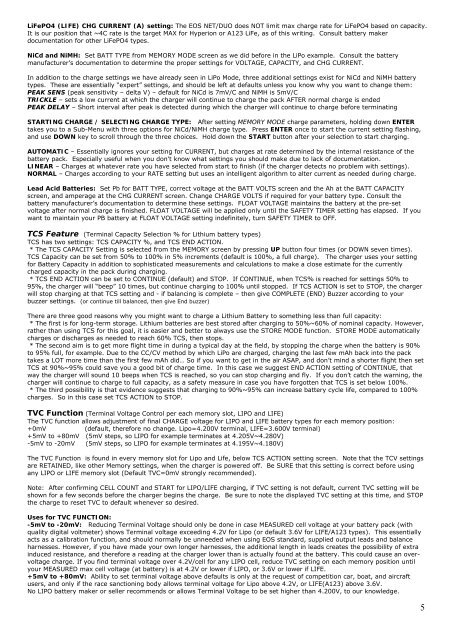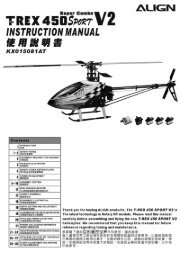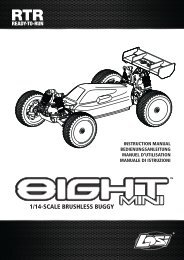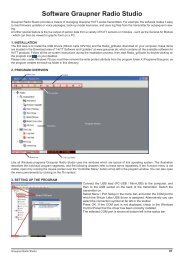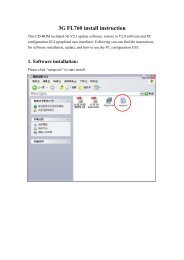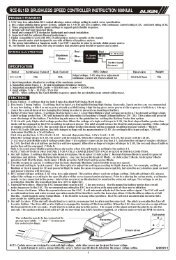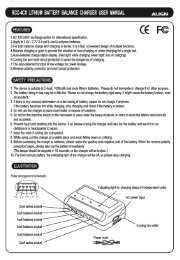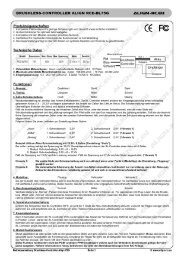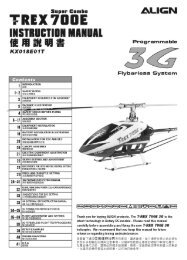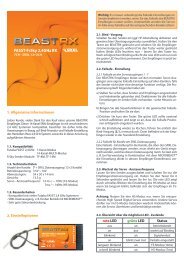DUO2 User Manual - Hyperion
DUO2 User Manual - Hyperion
DUO2 User Manual - Hyperion
Create successful ePaper yourself
Turn your PDF publications into a flip-book with our unique Google optimized e-Paper software.
LiFePO4 (LIFE) CHG CURRENT (A) setting: The EOS NET/DUO does NOT limit max charge rate for LiFePO4 based on capacity.<br />
It is our position that ~4C rate is the target MAX for <strong>Hyperion</strong> or A123 LiFe, as of this writing. Consult battery maker<br />
documentation for other LiFePO4 types.<br />
NiCd and NiMH: Set BATT TYPE from MEMORY MODE screen as we did before in the LiPo example. Consult the battery<br />
manufacturer’s documentation to determine the proper settings for VOLTAGE, CAPACITY, and CHG CURRENT.<br />
In addition to the charge settings we have already seen in LiPo Mode, three additional settings exist for NiCd and NiMH battery<br />
types. These are essentially “expert” settings, and should be left at defaults unless you know why you want to change them:<br />
PEAK SENS (peak sensitivity – delta V) – default for NiCd is 7mV/C and NiMH is 5mV/C<br />
TRICKLE – sets a low current at which the charger will continue to charge the pack AFTER normal charge is ended<br />
PEAK DELAY – Short interval after peak is detected during which the charger will continue to charge before terminating<br />
STARTING CHARGE / SELECTING CHARGE TYPE: After setting MEMORY MODE charge parameters, holding down ENTER<br />
takes you to a Sub-Menu with three options for NiCd/NiMH charge type. Press ENTER once to start the current setting flashing,<br />
and use DOWN key to scroll through the three choices. Hold down the START button after your selection to start charging.<br />
AUTOMATIC – Essentially ignores your setting for CURRENT, but charges at rate determined by the internal resistance of the<br />
battery pack. Especially useful when you don’t know what settings you should make due to lack of documentation.<br />
LINEAR – Charges at whatever rate you have selected from start to finish (if the charger detects no problem with settings).<br />
NORMAL – Charges according to your RATE setting but uses an intelligent algorithm to alter current as needed during charge.<br />
Lead Acid Batteries: Set Pb for BATT TYPE, correct voltage at the BATT VOLTS screen and the Ah at the BATT CAPACITY<br />
screen, and amperage at the CHG CURRENT screen. Change CHARGE VOLTS if required for your battery type. Consult the<br />
battery manufacturer’s documentation to determine these settings. FLOAT VOLTAGE maintains the battery at the pre-set<br />
voltage after normal charge is finished. FLOAT VOLTAGE will be applied only until the SAFETY TIMER setting has elapsed. If you<br />
want to maintain your PB battery at FLOAT VOLTAGE setting indefinitely, turn SAFETY TIMER to OFF.<br />
TCS Feature (Terminal Capacity Selection % for Lithium battery types)<br />
TCS has two settings: TCS CAPACITY %, and TCS END ACTION.<br />
* The TCS CAPACITY Setting is selected from the MEMORY screen by pressing UP button four times (or DOWN seven times).<br />
TCS Capacity can be set from 50% to 100% in 5% increments (default is 100%, a full charge). The charger uses your setting<br />
for Battery Capacity in addition to sophisticated measurements and calculations to make a close estimate for the currently<br />
charged capacity in the pack during charging.<br />
* TCS END ACTION can be set to CONTINUE (default) and STOP. If CONTINUE, when TCS% is reached for settings 50% to<br />
95%, the charger will “beep” 10 times, but continue charging to 100% until stopped. If TCS ACTION is set to STOP, the charger<br />
will stop charging at that TCS setting and - if balancing is complete – then give COMPLETE (END) Buzzer according to your<br />
buzzer settings. (or continue till balanced, then give End buzzer)<br />
There are three good reasons why you might want to charge a Lithium Battery to something less than full capacity:<br />
* The first is for long-term storage. Lithium batteries are best stored after charging to 50%~60% of nominal capacity. However,<br />
rather than using TCS for this goal, it is easier and better to always use the STORE MODE function. STORE MODE automatically<br />
charges or discharges as needed to reach 60% TCS, then stops.<br />
* The second aim is to get more flight time in during a typical day at the field, by stopping the charge when the battery is 90%<br />
to 95% full, for example. Due to the CC/CV method by which LiPo are charged, charging the last few mAh back into the pack<br />
takes a LOT more time than the first few mAh did… So if you want to get in the air ASAP, and don’t mind a shorter flight then set<br />
TCS at 90%~95% could save you a good bit of charge time. In this case we suggest END ACTION setting of CONTINUE, that<br />
way the charger will sound 10 beeps when TCS is reached, so you can stop charging and fly. If you don’t catch the warning, the<br />
charger will continue to charge to full capacity, as a safety measure in case you have forgotten that TCS is set below 100%.<br />
* The third possibility is that evidence suggests that charging to 90%~95% can increase battery cycle life, compared to 100%<br />
charges. So in this case set TCS ACTION to STOP.<br />
TVC Function (Terminal Voltage Control per each memory slot, LIPO and LIFE)<br />
The TVC function allows adjustment of final CHARGE voltage for LIPO and LIFE battery types for each memory position:<br />
+0mV (default, therefore no change. Lipo=4.200V terminal, LIFE=3.600V terminal)<br />
+5mV to +80mV (5mV steps, so LIPO for example terminates at 4.205V~4.280V)<br />
-5mV to -20mV (5mV steps, so LIPO for example terminates at 4.195V~4.180V)<br />
The TVC Function is found in every memory slot for Lipo and Life, below TCS ACTION setting screen. Note that the TCV settings<br />
are RETAINED, like other Memory settings, when the charger is powered off. Be SURE that this setting is correct before using<br />
any LIPO or LIFE memory slot (Default TVC=0mV strongly recommended).<br />
Note: After confirming CELL COUNT and START for LIPO/LIFE charging, if TVC setting is not default, current TVC setting will be<br />
shown for a few seconds before the charger begins the charge. Be sure to note the displayed TVC setting at this time, and STOP<br />
the charge to reset TVC to default whenever so desired.<br />
Uses for TVC FUNCTION:<br />
-5mV to -20mV: Reducing Terminal Voltage should only be done in case MEASURED cell voltage at your battery pack (with<br />
quality digital voltmeter) shows Terminal voltage exceeding 4.2V for Lipo (or default 3.6V for LIFE/A123 types). This essentially<br />
acts as a calibration function, and should normally be unneeded when using EOS standard, supplied output leads and balance<br />
harnesses. However, if you have made your own longer harnesses, the additional length in leads creates the possibility of extra<br />
induced resistance, and therefore a reading at the charger lower than is actually found at the battery. This could cause an overvoltage<br />
charge. If you find terminal voltage over 4.2V/cell for any LIPO cell, reduce TVC setting on each memory position until<br />
your MEASURED max cell voltage (at battery) is at 4.2V or lower if LIPO, or 3.6V or lower if LIFE.<br />
+5mV to +80mV: Ability to set terminal voltage above defaults is only at the request of competition car, boat, and aircraft<br />
users, and only if the race sanctioning body allows terminal voltage for Lipo above 4.2V, or LIFE(A123) above 3.6V.<br />
No LIPO battery maker or seller recommends or allows Terminal Voltage to be set higher than 4.200V, to our knowledge.<br />
5


